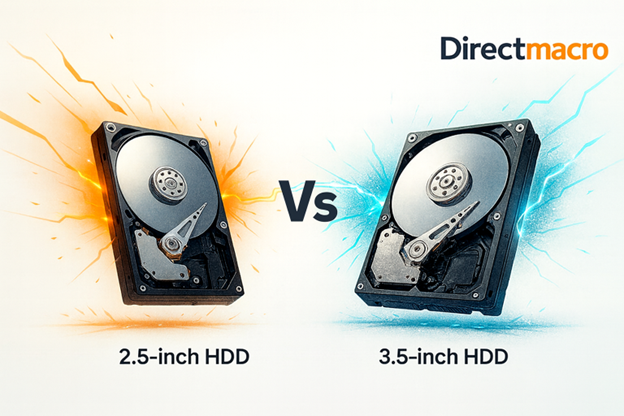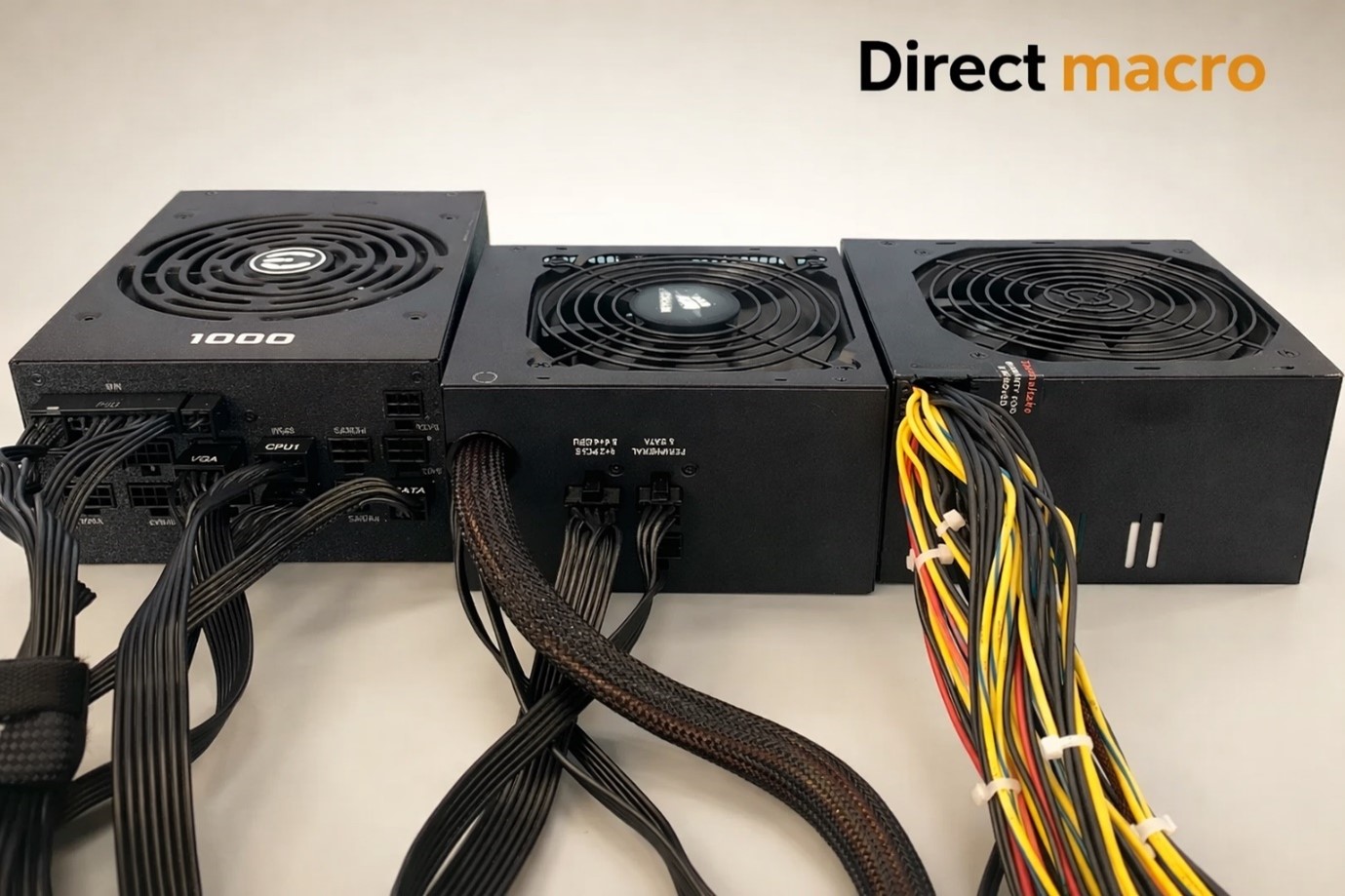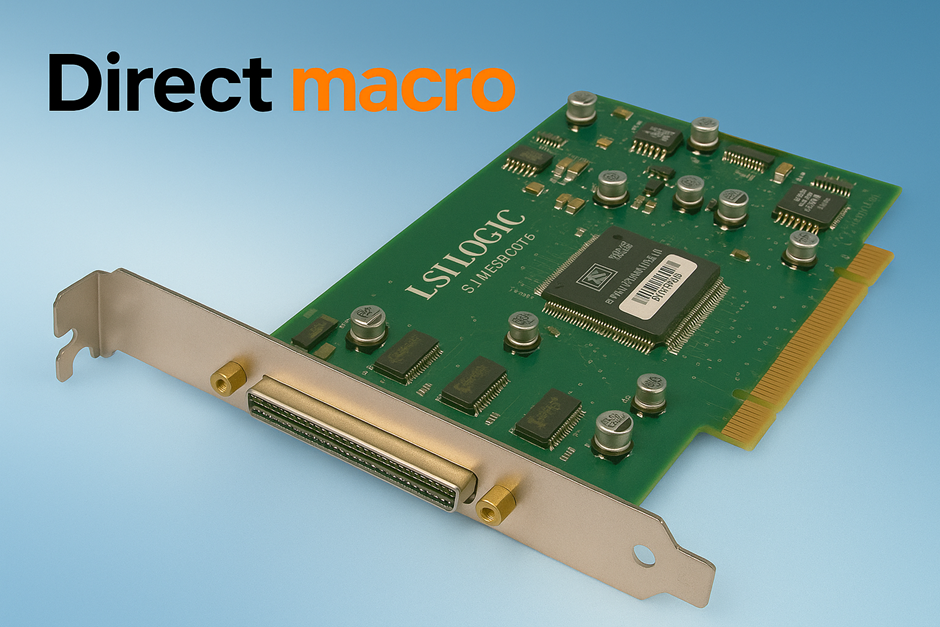2.5 vs 3.5 HDD: Which Offers Better Performance and Storage?
When you buy a traditional hard disk drive, you will most likely come across the 2.5-inch HDDs and the 3.5-inch HDDs options. Although they seem to be the same, since both have spinning platters, magnetic heads, and SATA or SAS interfaces, they both possess different strengths. This guide simply breaks down the 2.5 vs. 3.5 HDD comparison. If you need to pair the right hard disk drive to a PC, NAS, or server, this guide is for you. This guide aims to answer some common questions that people also ask, such as the difference between 2.5 vs. 3.5 hard drive speeds, power consumption, reliability, connectors, and others. In a nutshell, this guide will provide you with the most cost-effective solution that suits your workload and budget.
2.5-inch HDDs vs. 3.5-inch HDDs: Size, Use Cases, and Fit
A glance at size, use cases, and fit for 2.5-inch HDDs vs. 3.5-inch HDDs helps you understand which option works best. This section highlights essential differences to guide your choice with clarity and confidence. Check out this quick comparison of these capacities.
Quick Comparison
| Feature | 2.5-inch HDD | 3.5-inch HDD |
| Width | ~69.85 mm | ~101.6 mm |
| Thickness | 7–15 mm | ~26 mm |
| Primary Use | Laptops, small-form-factor desktops, consoles, portable enclosures | Desktops, workstations, most NAS and server bays |
| Capacity Potential | Limited (fewer platters due to smaller size) | Higher (larger chassis allows more platters → higher max capacity) |
| Weight | Lighter (~90–120 g typical) | Heavier (~400–700 g typical) |
| Power Consumption | Lower (around 1.5–3 W active, <1 W idle) | Higher (around 6–9 W active, ~3–5 W idle) |
Where each shines:
- 2.5-inch: This HDD size offers compact builds, external portable options, low-power or quiet systems, and edge devices.
- 3.5-inch: 3.5-inch HDDs offer high-capacity desktops, media servers, surveillance systems, and most commonly NAS arrays.
2.5 vs 3.5 HDD Speed, Performance and Throughput
When comparing the 2.5 vs 3.5 HDD speed drives, 3.5-inch drives have much higher sustained transfer rates. Why?
- Higher Platter Density and Diameter: Larger platters can store more data per rotation and move beyond the read head much quicker at the same RPM.
- RPM Choices: Most consumer 3.5-inch drives have a speed of 7200 RPM and some models even higher, while the consumer 2.5-inch HDDs range mostly from 5400 RPM to conserve energy and minimize heat generation. (Enterprise 2.5-inch SAS drives can go up to 10K to 15K RPM, but those drives are not typically used in laptops or basic NAS units.)
- Cache Sizes: 3.5-inch drives are known to have larger caches, which support burst workloads.
3.5-inch drives feel much faster for backups, streaming media, and large file transfers. If raw throughput is your top criterion in 2.5 vs 3.5 HDD, pick 3.5-inch.
Quick Comparison
Here is a clean comparison table that showcases the performance and throughput of 2.5-inch vs 3.5-inch HDD speed:
| Feature / Metric | 2.5-inch HDD | 3.5-inch HDD |
| Typical RPM (Rotations per Minute) | 5,400 – 7,200 RPM (common in laptops, some energy-efficient desktops) | 7,200 – 10,000+ RPM (desktop & enterprise models) |
| Average Sequential Read/Write Speed | ~80 – 120 MB/s | ~150 – 210 MB/s |
| Throughput / IOPS | Lower (~55–80 IOPS) | Higher (~80–120+ IOPS) |
| Latency | Slightly higher due to smaller cache and lower RPM | Lower latency (faster spindle speeds & larger cache) |
| Power Consumption | 1.5 – 3 W (energy-efficient, good for laptops) | 6 – 9 W (higher power draw, requires more cooling) |
| Heat Output | Low | Higher (due to larger platters and faster speeds) |
| Use Case | Laptops, portable storage, energy-sensitive servers | Desktops, workstations, servers requiring high throughput |
Summary
- 5-inch HDDs: This option focuses on portability, low power, and compact design but compromises raw speed.
- 5-inch HDDs: These HDDs deliver better performance and throughput, making them ideal for desktops and servers where space and power are less of a concern.
Capacity, Cost per TB, and Growth Room of 2.5 vs 3.5 HDD
Capacity is the 3.5-inch game changer. Because of the larger housing and more platters, 3.5-inch HDDs offer much higher single-drive capacity at a lower cost per terabyte. This is great for storing large amounts of data, such as movies, raw pictures, virtual machine images, surveillance footage, and backup files. 2.5-inch hard drives often have smaller capacity. They are good for ordinary laptop storage or lightweight portable archives, but 3.5-inch is the way to go for multi-TB arrays on a budget.
- Form Factor Capacities
According to the most recent form factor requirements, 2.5-inch HDDs can now hold up to 6TB of data, while 3.5-inch HDDs can hold up to 36TB. - Cost per TB
According to market-tracking sites like DiskPrices.com, internal 3.5-inch HDDs typically cost less per TB than internal 2.5-inch HDDs, especially for bigger capacity. - Growth Room / Capacity Upgrades
Because the 3.5-inch form factor permits more platters and higher density, as seen with technologies such as HAMR, there is significantly more space for capacity increases in 3.5″ HDDs.
Quick Comparison
Here is a more detailed table, comparing 2.5-inch vs 3.5-inch HDDs across multiple attributes:
| Parameter | 2.5-inch HDD | 3.5-inch HDD |
| Typical Max Capacity | Up to ~6 TB (consumer) | Up to ~36 TB (consumer / enterprise) |
| Cost per TB | Higher per TB, especially above 2-4 TB | Lower per TB at high capacities; better bulk value |
| Growth Room | Limited: fewer platters, space/power/heat constraints. Better for small upgrades. | Much larger room: newer tech (HAMR, high density platters) is pushing capacities higher; good for future expansion. |
| Physical Size / Weight / Mounting | Much smaller, lighter; fits in laptops, portable enclosures; less cooling needed. | Larger size; more weight; needs more robust mounting, better cooling and vibration management. |
| Heat / Noise / Vibrations | Quieter, less heat output. Better for constrained spaces (laptops, small NAS boxes). | Generates more heat, more noise/vibration; in multi-bay scenarios, needs cooling and vibration control. |
| Reliability & Durability (Wear Factors) | Lower stress from spindle, etc., but more sensitive to shock if moved. Smaller platters may reduce seek distance. | More robust in stationary setups; more platters mean more mechanical parts and potentially more failure points, but in many cases, they are designed for 24/7 operation. |
| Use-Case Suitability | Best for laptops, portable backup, external drives, and lighter NAS setups. | Best for desktops, bulk storage, media servers, enterprise/high-capacity NAS, and backup servers. |
2.5 vs 3.5 HDD Power Consumption, Heat, And Acoustics Analysis
Energy efficiency is a clear differentiator when comparing 2.5-inch and 3.5-inch hard drives. Smaller 2.5-inch drives naturally consume less power, which not only reduces electricity costs but also helps manage heat output and keeps system acoustics quieter. On the other hand, 3.5-inch drives, while more powerful and higher in capacity, draw more energy and generate extra heat, often requiring better cooling solutions.
Quick Comparison
Here is a clean comparison table for power, heat, and acoustics of 2.5 vs 3.5 hdd size.
| Feature | 2.5″ HDD | 3.5″ HDD |
| Idle Power Consumption | ~0.8W – 1.5W | ~4W – 6W |
| Active Power Consumption (Read/Write) | ~2W – 3W | ~6W – 9W |
| Startup/Inrush Power | ~4W – 5W | ~15W – 25W |
| Heat Generation | Lower (compact, less spinning mass) | Higher (larger platters, more friction) |
| Cooling Requirements | Minimal, often sufficient with airflow | Requires proper cooling (dedicated airflow/fans recommended) |
| Acoustics (Noise Levels) | Quieter (20–28 dB typical) | Louder (25–36 dB typical, depending on RPM) |
| Common Use Cases | Laptops, portable external drives, low-power servers | Desktops, NAS, enterprise servers, high-capacity storage |
Summary
- 2.5-inch HDDs are more power-efficient, generate less heat, and are quieter. These HDDs are ideal for laptops and portable storage.
- 3.5-inch HDDs consume more power, run hotter, and are louder, but they offer higher capacities and better sustained performance for desktops and servers.Bottom of Form
2.5 vs 3.5 HDD Connectors and Power Rails
Both sizes commonly use standard SATA data connectors or SAS in enterprise gear. The big difference is power. Let’s quickly compare 2.5 vs. 3.5-inch HDD connectors and power rails.
Quick Comparison
| Feature | 2.5-inch HDD | 3.5-inch HDD |
| Power Connector | Uses standard SATA power connector (5V rail only) | Uses standard SATA power connector (both 5V and 12V rails) |
| Data Connector | Standard SATA data connector | Standard SATA data connector |
| Legacy Connector (Older Models) | Some models had combined PATA/IDE connectors with 44-pin design (power + data in one) | Older models often used Molex 4-pin for power and separate PATA/IDE |
| Power Requirements | Low power; primarily operates on 5V rail | Higher power; requires both 5V (logic) and 12V (spindle motor) |
| Form Factor Integration | Often used in laptops and compact devices with a single connector for simplicity | Common in desktops, workstations, and servers with dedicated power rails |
| Hot-Swap Support (SATA) | Supported in enterprise/laptop bays if controller allows | Supported in enterprise/server environments with proper backplane |
In Short:
- 5-inch HDDs operate solely on the 5V rail, making them efficient and compact.
- 5-inch HDDs require both 5V and 12V rails to power larger platters and motors.
This affects adapters and enclosures. If you are relocating a 3.5-inch drive to a USB enclosure or docking station, make sure it has 12V power. When deciding between 2.5 vs 3.5 HDD connectors, first consider the specifications of your case, power supply, or enclosure.
2.5 vs 3.5 HDDs: Reliability, Durability, and Lifespan
A lot of people ask about 2.5 vs 3.5 HDD reliability and 2.5 vs 3.5 HDD lifespan. It depends on the model and workload of your device, not just size. Still, some tendencies are worth noting:
1. Shock Resistance and Durability
2.5-inch drives are more suited to physical handling, such as lower mass and smaller platters, making them ideal for laptops and portable enclosures. This lends credence to the assumption that 2.5 vs 3.5 HDDs last longer when moved about.
2. Thermals and Duty Cycle
Many 3.5-inch NAS or enterprise models are rated for 24/7 operation with higher workload limits (measured in TB/year). They are designed to sit in a chassis and churn. They can exhibit excellent longevity with adequate cooling.
3. Environment Matters
Vibration, temperature, and power quality affect lifespan for both HDD sizes. A 3.5-inch NAS-rated HDD in a well-cooled array can outlast a basic 2.5-inch laptop drive used beyond its intended duty cycle. Conversely, a 2.5-inch drive in a shock-prone setting may survive drops better than a 3.5-inch.
Bottom Line On 2.5 Vs 3.5 HDD Reliability
Choose a drive line designed for your use case, such as NAS, surveillance, desktop, or mobile. That choice influences lifespan more than form factor alone.
2.5 vs 3.5 HDD for NAS: Which Is Better?
If you are wondering why NAS enclosures and other vendors recommend using 3.5-inch HDDs for capacity, consider these pointers if you are evaluating 2.5 vs 3.5 HDD for NAS.
- 3.5-inch NAS drives (typically labeled as NAS or Pro) have greater capacity, decent sequential speed, and RAID-specific firmware such as TLER, ERC settings, and vibration tolerance. They are the most popular choice for Plex servers, photo libraries, and SMB file servers.
- 2.5-inch HDDs can be used in NAS; some enclosures support them natively or via adapters; nevertheless, capacity ceilings are lower. They operate quieter and cooler, which is useful in cramped quarters, but for multi-bay arrays and long-term growth, 3.5-inch remains the practical choice.
The 2.5-inch drives are great, but only for those who want low noise and modest capacity. The 3.5-inch drives are best for big storage pools and expansion headroom.
Real-World Workflows: Who Should Choose What?
Use these scenarios to anchor your 2.5 vs 3.5 HDD decision:
- Laptop And Portable Storage
If you are a laptop user, go for a 2.5-inch HDD. You will save power, heat, and weight; your enclosure won’t need 12V power. - Desktop Gaming and Media Workstation
If you are looking for an HDD for your desktop gaming and media workstation, then prefer a 3.5-inch for faster large-file throughput and bigger capacities. Pair it with an SSD for OS and games. - Home NAS, Plex and Backups
Choose 3.5-inch NAS-rated drives for the best cost per TB and RAID behavior. If we compare 2.5 vs 3.5 HDD for NAS, the 3.5-inch is the top choice for most users looking for a home NAS setup. - Rugged Or Mobile Edge Devices
Go 2.5-inch for better shock tolerance, lower power consumption, and quieter operation.
2.5 Vs 3.5 HDD Connector and Size Compatibility Checklist
Before purchasing your next HDD, consider these key factors. These factors help you to make the right purchase and protect you from losing your money:
1. Bay Fit
Always check your case or NAS for proper tray compatibility, such as 2.5-inch or 3.5-inch bays, or adapters required for installation.
2. Power
Ensure your PSU provides correct SATA power rails, such as 2.5-inch drives needing 5V, while 3.5-inch drives require both 5V and 12V.
3. Interface
Match drive and system interfaces carefully. Consumer PCs typically support SATA only. Mixing SATA with SAS without planning causes compatibility problems.
4. Vibration Control
In multi-bay NAS setups, secure drives properly. Anti-vibration mounts or trays help extend 3.5-inch drive life under continuous workloads.
5. Firmware Features
NAS and RAID setups require reliability. Look for TLER/ERC support or NAS-optimized firmware, ensuring consistent performance during error recovery cycles.
Final Thoughts
When it comes down to choosing between 2.5-inch vs 3.5-inch HDD, it is really about matching the drive to your needs rather than just comparing specifications. If you want maximum capacity, lower cost per terabyte, and stronger sequential performance, the 3.5-inch HDD clearly leads the way. It has a large storage capacity, making it ideal for desktops and NAS setups. On the other hand, if portability, lower heat, and quieter operation are more important than the compact 2.5-inch HDD, it makes perfect sense.
In short, 3.5-inch drives dominate in performance and storage density, while 2.5-inch drives shine with efficiency, durability on the move, and gentler power use. Both share common connectivity options, but keep in mind that 3.5-inch models typically need extra power. Ultimately, lifespan depends less on size and more on the model and workload, so opting for enterprise or NAS-grade drives is smart for everyday use. Choose the drive that fits your environment and workload because the right choice depends on how you plan to use it.
For more assistance, please call us at (855) 483-7810 or visit our contact us page for more details about product purchases. Our professional team loves to assist you 24/7.
FAQs
- Is a 3.5-inch HDD always faster than a 2.5-inch HDD?
Not always, but usually. 3.5-inch models often have higher RPMs, larger caches, and bigger platters that favor sequential speed for consumer SATA drives. Enterprise-grade 2.5-inch SAS drives can be very fast, but they are a different and costlier category. 2.5 vs 3.5 hdd speed favors 3.5-inch for typical desktop use. - Can I use 2.5-inch HDDs in a NAS?
Yes, if your NAS supports 2.5-inch bays or adapters, you can use a 2.5-inch HDD in a NAS setup. However, for 2.5 vs 3.5 hdd for NAS, 3.5-inch NAS-rated drives are recommended due to higher capacities, better cost per TB, and firmware tuned for RAID. - Do 2.5-inch drives last longer than 3.5-inch drives?
2.5 vs 3.5 hdd lifespan depends more on the specific model and workload. 2.5-inch drives can be more shock-resistant, while 3.5-inch NAS or enterprise models are built for 24/7 uptime. Choose a drive class that matches how you will use it. - How to know if a drive is 2.5″ or 3.5″?
Find the physical size of a drive to known the exact size of your drive. The 2.5″ drives are smaller and thinner. They are commonly used in laptops, while 3.5″ drives are larger and used in desktops. Labels or model numbers also indicate the form factor of the drive.
Do you need advice on buying or selling hardware? Fill out the form and we will return.

Sales & Support
(855) 483-7810
We respond within 48 hours on all weekdays
Opening hours
Monday to thursday: 08.30-16.30
Friday: 08.30-15.30








